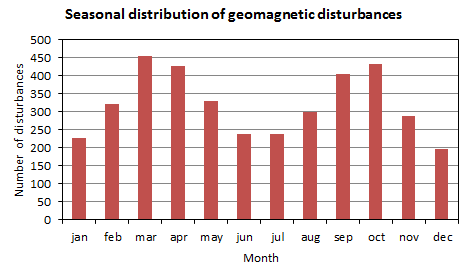The Seasonal Distribution of Geomagnetic Disturbances
Each month, ASWFC lists the geomagnetic storms in the Monthly Solar and Geophysical Report. A geomagnetic storm is a period of time during which the direction and the strength of the Earth's magnetic field is observed to be varying. Whilst these changes are of small amplitude, not able to be seen on an ordinary magnetic compass, they are important to many systems such as magnetic surveys for minerals, and the operation of pipe lines and power lines. They are also important because geomagnetic disturbances usually correspond with a disturbed ionosphere and difficult HF communications.
Geomagnetic disturbances are not equally likely in every month of the year. The graph illustrates this fact for geomagnetic disturbances where the daily planetary Ap index exceeds a value of 25 (a disturbance which might occur on average four times per month). The data in the graph come from the years 1932 to 2014 inclusive.
Geomagnetic disturbances tend to occur most frequently in the equinox months of March/April and September/October. They are least common during the solstice months of December/January and June/July. For disturbances of this size there are approximately twice the number of disturbances near the equinoxes as near the solstices.
If we consider much larger disturbances then we find an even greater concentration near the equinoxes. So, if your work is affected by geomagnetic disturbances, then it is wise to avoid the equinox months if you can!

Material prepared by Richard Thompson





